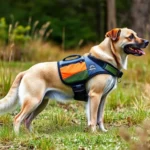
Regular exercise is essential for dogs, providing them with a healthy and balanced lifestyle. Just like humans, dogs require physical activity to maintain their health, manage their weight, and reduce the risk of various health issues. As pet owners become increasingly aware of the importance of canine fitness, the demand for specialized dog exercise equipment has surged. In this article, we’ll explore the significance of dog exercise, the types of equipment available, how to choose the right gear, and tips for incorporating this equipment into your dog’s routine.
Understanding the Importance of Dog Exercise
Benefits of Regular Exercise for Dogs
Regular exercise is crucial for dogs for multiple reasons:
- Physical Health Benefits: Exercise helps maintain a healthy weight, promotes muscle development, and supports joint health. It can prevent obesity, which is a common issue among pets leading to various health complications.
- Mental Health Benefits: Just like humans, dogs can suffer from anxiety and boredom. Regular physical activity helps reduce these issues, decreasing destructive behaviors that may arise from lack of stimulation.
- Bonding Opportunities: Engaging in activities together, whether it’s a brisk walk, fetch, or agility training, strengthens the bond between the dog and the owner.
Factors Influencing Dog Exercise Needs
Understanding that not all dogs have the same exercise requirements is vital. Several factors affect how much exercise your dog needs, including:
- Breed: Active breeds like Border Collies and Labrador Retrievers typically require more exercise than smaller, less active breeds.
- Age: Puppies have high energy levels, while older dogs might need more gentle exercises.
- Health Status: Dogs with certain health issues or injuries may require tailored exercise routines.
- Living Situation: The environment also plays a role; dogs living in apartments may have different exercise needs compared to those with large backyards.
Types of Dog Exercise Equipment
Overview of Popular Dog Exercise Equipment
Utilizing dog exercise equipment can significantly enhance your dog’s workout routine. Here’s a look at some popular types of equipment and their benefits:
- Treadmills: Great for rainy days or when you’re short on time.
- Agility Equipment: Helps improve coordination and mental stimulation.
- Interactive Toys: Keeps dogs engaged and active.
- Leashes and Collars: Essential for safe outdoor exercise.
- Fitness Accessories: Weighted vests or swimming gear to challenge your dog physically.
Leashes and Collars
When it comes to dog exercise equipment, leashes and collars are fundamental. Here’s a breakdown:
- Standard Leashes: Provide control during walks.
- Retractable Leashes: Allow dogs to explore while still being attached.
- Hands-Free Leashes: Perfect for joggers who want to keep their hands free while exercising with their dog.
Choosing between a collar and a harness often depends on the dog’s behavior and health. Harnesses distribute pressure more evenly and are ideal for dogs that pull.
Toys for Exercise
Interactive toys can provide a fun way to keep your dog active. For example:
- Frisbees and Balls: Great for outdoor play and exercise.
- Tug Toys: Help strengthen muscles while also being an enjoyable activity.
Agility Equipment
Agility training is an excellent way to provide both physical and mental exercise. Common types of agility equipment include:
- Tunnels: Encourage dogs to run and navigate through obstacles.
- Jumps: Help improve strength and coordination.
- Weave Poles: Great for enhancing agility and focus.
Treadmills for Dogs
Dog treadmills are a fantastic option for exercise, especially for busy owners. Here’s what you need to know:
- How They Work: Just like human treadmills, dog treadmills allow pets to walk or run at their own pace indoors.
- Pros: They provide a controlled environment for exercise and can be useful during inclement weather.
- Cons: Some dogs may require time to adjust to using a treadmill, and supervision is essential to ensure safety.
Fitness Accessories
Fitness accessories can further enhance your dog’s workout routine:
- Weighted Vests: Adding weight can increase the intensity of workouts, promoting more significant muscle development.
- Pool Equipment: If your dog enjoys water, swimming gear can help facilitate safe aquatic exercise.
How to Choose the Right Dog Exercise Equipment
Assessing Your Dog’s Needs
When selecting dog exercise equipment, it’s essential to assess your dog’s specific needs:
- Breed Considerations: Research your dog’s breed to understand its exercise requirements and preferences.
- Age and Health: Consider any health conditions or age-related factors that may influence the type of equipment you choose.
Quality and Safety Considerations
Quality and safety should never be compromised when purchasing exercise equipment. Here are key points to keep in mind:
- Materials: Ensure that the equipment is made from durable, non-toxic materials.
- Design: Look for designs that are safe and suitable for your dog’s size and activity level.
- Safety Features: Check for features like non-slip surfaces on treadmills and secure fastenings on harnesses.
Budgeting for Dog Exercise Equipment
Dog exercise equipment comes in various price ranges. Here are some budgeting tips:
- Determine Your Needs: Identify which types of equipment are essential for your dog’s routine.
- Research Options: Compare products and read reviews to find affordable yet effective gear.
- Consider DIY Solutions: Some equipment, such as agility jumps, can be made at home using inexpensive materials.
Incorporating Exercise Equipment into Your Dog’s Routine
Creating a Balanced Exercise Routine
To keep your dog engaged and healthy, it’s essential to create a balanced exercise routine that includes:
- Mixing Activities: Combine equipment-based workouts with outdoor activities like walking and playing fetch.
- Variety: Add different types of exercises to prevent boredom and keep your dog motivated.
Tips for Training Your Dog to Use Equipment
Introducing your dog to new exercise equipment can be a fun experience:
- Start Slowly: Allow your dog to explore the equipment at their own pace.
- Use Positive Reinforcement: Reward your dog with treats or praise to encourage them to engage with the equipment.
- Be Patient: Some dogs may take longer to adapt to using equipment, so patience is key.
Monitoring Your Dog’s Progress
Keeping track of your dog’s fitness levels is crucial for ensuring their health:
- Regular Check-Ins: Monitor their weight, energy levels, and overall health.
- Adjust Routines: Be ready to adapt exercise routines based on your dog’s behavior and health changes.
Popular Brands and Recommendations
Top Brands for Dog Exercise Equipment
Choosing reputable brands can help ensure you invest in quality dog exercise equipment. Here are some well-known brands:
- PetZen: Especially known for their dog treadmills, offering a range of sizes for different breeds.
- Outward Hound: Offers a variety of interactive toys and agility equipment.
- SportDOG: Known for durable leashes and collars designed for active dogs.
Customer Testimonials and Case Studies
Many dog owners have successfully integrated exercise equipment into their pets’ routines. Here are a few highlights:
- A Labrador owner reported significant weight loss and improved stamina after using an agility kit.
- A small breed owner shared how a treadmill helped their dog stay active during winter months.
Conclusion
Regular exercise is vital for maintaining your dog’s health and happiness, and investing in dog exercise equipment can enhance their lifestyle significantly. By understanding your dog’s needs and incorporating the right equipment into their routine, you can ensure they remain fit and engaged. As a dog owner, it’s important to prioritize your pet’s fitness and well-being. Consider exploring the various types of equipment available and enjoy the journey of keeping your furry friend active and healthy!









